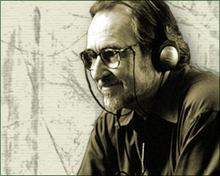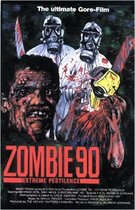Our editor-in-chief Nate Yapp is proud to have contributed to the new book Hidden Horror: A Celebration of 101 Underrated and Overlooked Fright Flicks, edited by Aaron Christensen. Another contributors include Anthony Timpone, B.J. Colangelo, Dave Alexander, Classic-Horror.com's own Robert C. Ring and John W. Bowen. Pick up a copy today from Amazon.com!
Wes Craven
It’s rare for a director to create landmark films in three separate decades, but horror master Wes Craven can claim that distinction. From setting up the template for bare knuckled, visceral horror in 1972’s Last House on the Left, through creating one of the genre’s most remembered fiends in 1984’s A Nightmare on Elm Street, and then re-inventing the slasher genre in 1996’s Scream, Craven continually strives to break new ground in screen horror.
The creative father of Freddy Krueger was born on August 2, 1939 in Cleveland, Ohio to devout Baptists Paul and Caroline Craven. After he grew up, he earned a Master’s degree in psychology and writing from Johns Hopkins University. He had a strong interest in filmmaking, however, and in 1972 he directed one of the most notorious films of the 1970s.
Craven and friend Sean S. Cunningham (who later fashioned the Friday the 13th series) created The Last House on the Left, a horror movie modeled after Ingmar Bergman's 1960 film The Virgin Spring. This harsh and brutal film told the story of two teenage girls who are savagely raped by a vicious gang of hoodlums. One of the girls’ parents exacts even worse revenge upon the thugs. The film’s clinical, almost documentary style presented its violence in a realistic and unromanticized manner, influenced greatly by the carnage of the Vietnam War. Craven’s shocking portrayal of visceral horror was extremely polarizing, yet it helped set a new standard for screen violence that lasted through the 1970s and beyond. The Texas Chainsaw Massacre (1974) is just one of the many films influenced by Craven’s first vision of terror.
Another of the films it influenced was Craven’s own The Hills Have Eyes. This 1977 movie revisited some of the ideas put forth in Last House, particularly the theme of a typical American family being confronted with a primal, violent mirror image of itself. This film cemented Craven’s reputation as a pioneer of screen horror. His career moved a bit unevenly in the next few years, with such unremarkable films as Deadly Blessing in 1981 and Swamp Thing in 1982. However, in 1981 Craven became interested in a series of articles in the LA Times regarding Cambodian refugee children who were mysteriously dying in their sleep after having terrible nightmares. These tragic articles gave Craven an idea that would forever change filmed horror.
The idea became, of course, A Nightmare on Elm Street. Perhaps the most influential horror film of the 1980s, Nightmare blended reality and dreams in an incredibly unique way and introduced the world to Freddy Krueger. Krueger, a dead child murder inhabiting the dreams of teenagers, became the classic anti-hero icon of that decade. In the original film, Freddy is a truly frightening creature wreaking bloody revenge. Craven treated the material very seriously, an approach not taken in the more comedic sequels. It is ironic that nearly every studio in Hollywood initially balked at this idea, in spite of the successes of films like Friday the 13th and The Evil Dead. New Line Cinema, which became known as “The House that Freddy Built,” finally agreed to back Craven’s unusual film. The result was a franchise that was still going strong in 2003 with the release of Freddy vs. Jason.
Following a sequel to The Hills Have Eyes in 1985 and after one of his weaker outings, Deadly Friend, in 1986, Craven returned to the Nightmare arena. His co-wrote and executive produced A Nightmare on Elm Street 3: Dream Warriors in 1987. After that film’s success, Craven next turned to the voodoo culture of Haiti for 1988’s The Serpent and the Rainbow, one of his most accomplished films. The story was inspired by a Harvard graduate student who had visited Haiti and investigated alleged methods of zombification. This serious film covers zombies, torture, and the violence of Duvalier’s Haiti. Serpent and the Rainbow included another of Craven’s patented reality bending sequences, and its rich photography and attention to detail demonstrate how much care Craven puts into crafting his films.
The late 1980s and early 1990s saw Craven directing such films as 1989’s Shocker (which has more than a few similarities to Nightmare), and 1991’s The People Under the Stairs, which offers another horrific investigation of the American family. In 1992, Craven created an anthology style TV show called Nightmare Café. Reminiscent of The Twilight Zone, and co-starring Freddy himself, Robert Englund, it was ultimately cancelled after only six episodes. The show’s cancellation, nevertheless, gave Craven the time to prepare what was to become perhaps his best film.
As early as 1987, Craven had toyed with the idea of a film in which the malevolent spirit of Fred Krueger escapes into the real world. When asked to develop a story for Nightmare 3, this was Craven’s first idea, but it was rejected. This may have been for the best, since by 1994, Freddy Krueger had become a cultural icon. Craven used this to great advantage in his singular masterpiece, Wes Craven’s New Nightmare. In this film, almost all of the actors play themselves, and nearly all of them, including Robert Englund, are veterans of the original film. In this film, Freddy is not a wise-cracking murderer, but rather the latest incarnation of an ancient evil that is occasionally caught and trapped by storytellers. This film skillfully mixes reality with fiction, and the result is one of the most thoughtful and original horror films in quite some time.
Next up for Craven was the horror-comedy Vampire in Brooklyn, in which he collaborated with Eddie Murphy. It is one of Craven’s lesser and more forgettable works, and was not a box office success. For his next project, Craven worked with screenwriter Kevin Williamson to revisit the idea of reality mixing with fiction. The result was the third of Craven’s landmark films.
That film was Scream (1996). With this one movie, Craven and Williamson redefined the slasher film genre, changing forever the ways they were written and produced. The characters are not brainless teens that are slowly killed one by one by an unstoppable killer. Instead, they are savvy, cool characters who know almost everything about horror films. The famous rules of surviving a horror film, “don’t drink, don’t have sex, and never say ‘I’ll be right back’” are rattled off by one of the characters. The love of slasher films is obvious in Scream and its two sequels (made in 1997 and 2000), even through Craven and Williamson poke a lot of fun at the slasher genre. Scream both looks back at the slasher film and redefines it at the same, and the sub-genre has not been the same since.
In the new millennium, Craven had directed two uneven films, Cursed in 2005, which is his and Williamson’s spin on lycanthropy, and, in the same year, Red Eye, a thriller set on an airplane. He has also been executive producer on such films Dracula 2000, and he produced the 2006 remake of The Hills Have Eyes, as well as writing its sequel, The Hills Have Eyes II in 2007. While he has ruled out being involved with any future Nightmare films, he is planning a remake of Shocker, and has also made some non-genre films, such as the Oscar-nominated Music of the Heart, as well. Wes Craven is one of horror’s true luminaries, who will hopefully continue to set new standards for screen horror.








